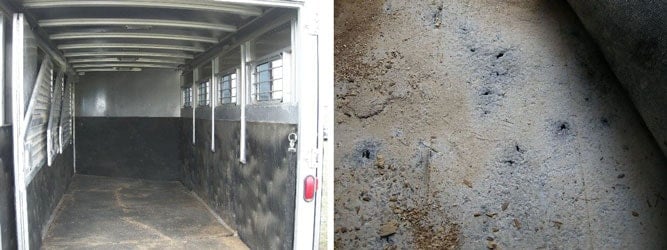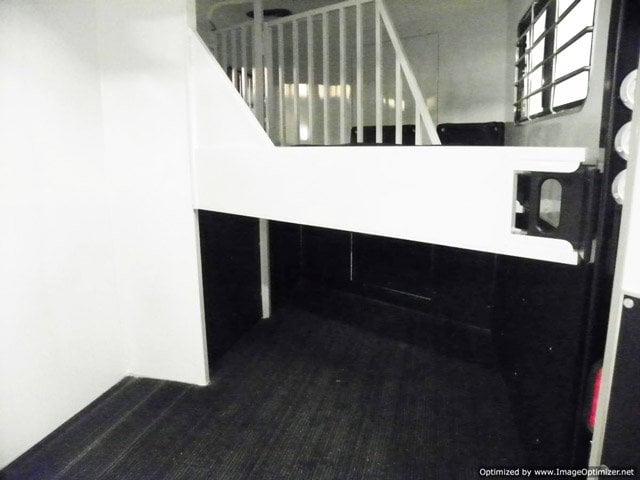How to Properly Use Horse Trailer Rubber Mats
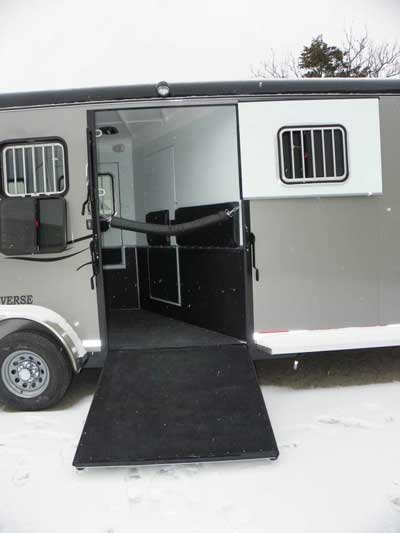 We can all agree that the floor of your horse trailer is pretty darn important. If your trailer floor is slippery or weak, your horse is in danger of serious injury. One vital component of your trailer floor is the rubber mat.
We can all agree that the floor of your horse trailer is pretty darn important. If your trailer floor is slippery or weak, your horse is in danger of serious injury. One vital component of your trailer floor is the rubber mat.
This article is going to talk about rubber mats in all their glory. What’s the best way to clean them? How can you prevent your horse from slipping? And how often should they be removed? It’s all below, so read on…
Types of Horse Trailer Flooring
Let’s first take a moment and describe the various types of floor available to you in your horse trailer.
Treated Pine Lumber (with Rubber Mats) – This first option is extremely strong, durable, and cost effective. In fact, it’s a popular choice for many of our customers. We use 2x8” pressure treated yellow pine in our lumber floors. And in 19 years, we have never had to replace a floor board for a customer. This stuff lasts!
Now, one word of caution, some companies will use side-to-side tongue and groove boards, untreated lumber, or even basic plywood. All of these options are going to degrade and rot over the years. Your horse’s urine is very acidic and it causes the wood to weaken and even fail. So, when we say “lumber flooring”, make sure that you are getting treated lumber that is properly installed.
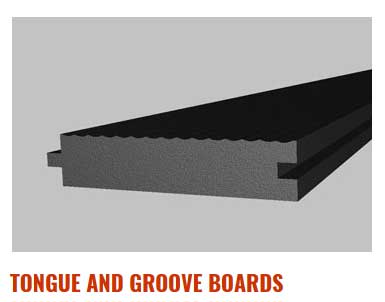 Rumber Flooring (without Rubber Mats) – The next option is a common upgrade for our customers. Like treated lumber, this synthetic “Rumber” material does a great job of minimizing heat, noise, and vibration transfer up into your horse’s legs. It is a synthetic recycled flooring made of tongue-and-groove boards. The material is made from old recycled tire bits.
Rumber Flooring (without Rubber Mats) – The next option is a common upgrade for our customers. Like treated lumber, this synthetic “Rumber” material does a great job of minimizing heat, noise, and vibration transfer up into your horse’s legs. It is a synthetic recycled flooring made of tongue-and-groove boards. The material is made from old recycled tire bits.
The main difference between this and the lumber is that Rumber does not need rubber mats on top. It can simply be sprayed down with a hose for cleaning. The downside is that it can be a bit more expensive. (see image of Rumber on right)
Aluminum Metal Floors (with Rubber Mats) – Aluminum sheets are installed in many trailer floors because they provide a quick solution with easy installation and lower cost. However, they are actually a terrible choice for flooring type and WE DO NOT RECOMMEND THEM. Aluminum floors transfer a great deal of heat, noise, and vibration up from the road surface. Plus, they rust and degrade over time causing a severe danger of floor failure.
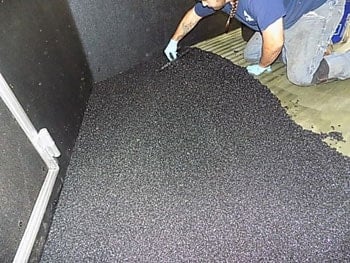
With WERM and Rhino coatings, we worry about moisture being introduced to the space between the lining and the floor that can cause degradation of the floor. With the Polylast, we worry that the porous material and “holes drilled in the metal floor” would weaken that metal floor and again introduce too much moisture. We’ve written in detail about how these materials are not an ideal choice for horse trailer floors. (WERM flooring in image on right.)
Are Rubber Mats Needed on Your Horse Trailer Floor Type?
As you can see above, some of the horse trailer floor types require rubber mats and other do not. Rumber and the synthetic coating options do not require rubber mats because they are made of rubber to begin with.
Treated lumber and aluminum floors do require rubber mats so that the horse’s hooves do not directly damage the floor material. These mats also provide extra “grip” for their feet and protect the floor from moisture. Acidic urine is your floor’s worst enemy and it can cause rot over time.
Should You Use Wood Shavings On Your Rubber Mats?
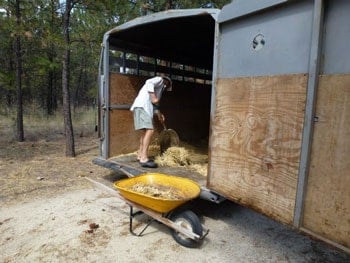
Yes, shavings can help soak up urine so that it doesn’t sit in puddles at your horse’s feet. And some users claim that their horse slips less during loading and unloading when the shavings are there to provide extra grip.
On the other hand, wet shavings can also cause other horses to slip more when loading and unloading. In addition, if any windows or air vents are open during travel, dust from the shavings can be breathed in by your horse.
So, should you put down wooden shavings in your horse trailer? We’d recommend that you try it first without these shavings. If you find that your horse does better with shavings, then that is fine as well. Just keep the windows closed so that your horse isn’t breathing in dust during your trip. Do what works best for your horse.
How to Prevent Slippery Mats
The main argument for or against wooden shavings has to do with your horse slipping on rubber mats. Here’s a neat trick. Try putting road salt or kitty litter down on your mats for the first few uses. Just like scuffing up a new pair of dance shoes, this will help roughen the surface of the mat to provide more grip.
Another consideration has to do with your loading practices. We’ve heard many people say that their horses only slip during loading or unloading. Make sure that you are using a trailer that allows your horse to load calmly. Our SafeTack Reverse Trailer allows horses to walk in from one door and exit out another so they never need to back. This type of orientation may allow your horse to remain calmer with less slippage.
How to Clean Your Trailer with Rubber Mats
Rubber mats are usually 4x8’ in size and turned crossways in the trailer. This means you end up with a seam every four feet and then around the perimeter. Horse urine with run into these seams and then seep underneath the mat to form a puddle on the floor surface.
With a metal aluminum floor, this acidic urine will oxidize and the floor will form pock marked rust spots over time. Yes, aluminum can form white rust. Brad Heath, owner of Double D Trailers, says, “In my opinion, I would recommend that users remove their rubber mats each and every use so they can hose out, dry, and then reinstall the mats on an aluminum floor.”
This image shows an aluminum horse trailer with the rubber mats (left) and with the mats removed (right.) Notice how the floor has been weakened by white rust spots. It's strength is compromised and this floor is in danger of breaking through under the horse's feet.
He continues, “If it’s a wooden floor, I don’t think it’s necessary to remove/hose/dry after every use because the urine doesn’t cause oxidation with the boards.”
Still, he goes on to explain that moisture that remains for extended periods of time will eventually cause rot. So, if you are using your trailer frequently, remove the mats and hose out your wooden floor trailer once per month. Allow the floor to completely dry and then replace the mats.
“With that being said, we’ve been using wood floors since 1997 and so far have yet to replace a board in any of our trailers. Wood floors hold up very, very well!”
If you’ve ever tried to move your rubber mats, you know that they can be extremely heavy. It’s a pain in the rear end to drag them out of your trailer, but it’s important that you properly clean the floor underneath to maintain its strength.
Is There an Easier Way to Clean Out Your Trailer?
Some people are still going to balk at the idea of moving their heavy rubber mats on a regular basis for cleaning. For these users, we recommend that you install a synthetic Rumber floor.
This material has all the benefits of rubber mats on a treated lumber floor plus they are much easier to clean. Simply sweep or hose out your trail after each use and allow it to dry. Read more about Rumber flooring here.
If you have any questions about the material in this article, please don’t hesitate to reach out to us. We’d be glad to help you find the perfect trailer flooring type to match your needs.

